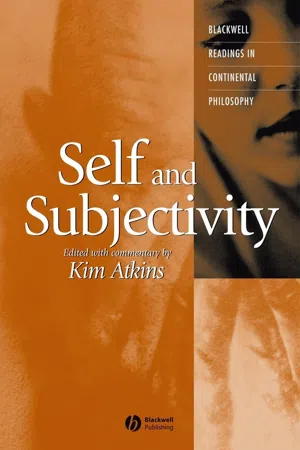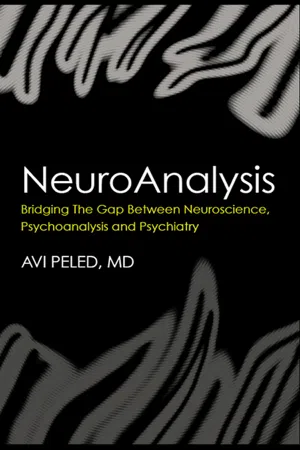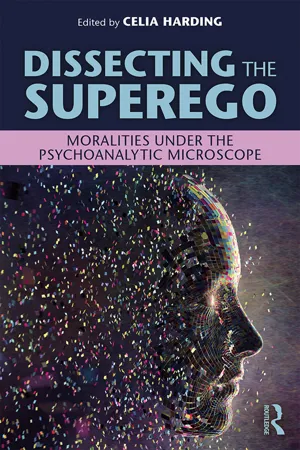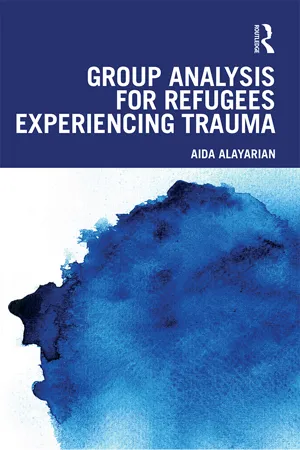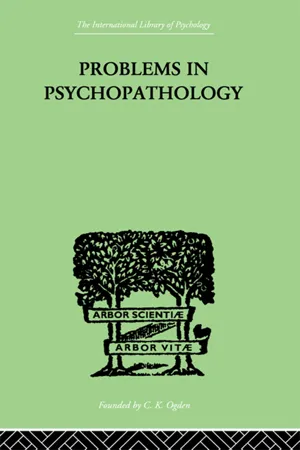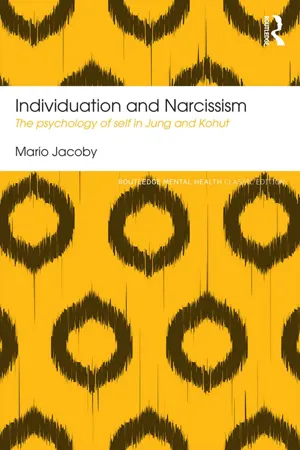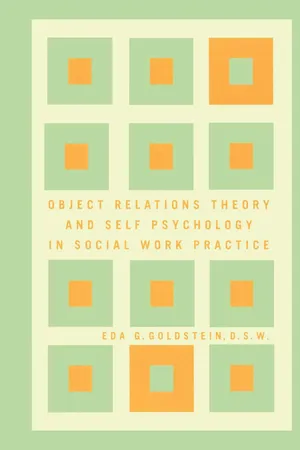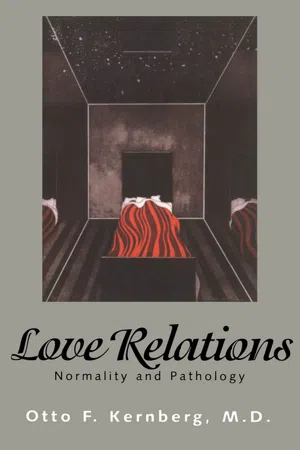Psychology
Id Ego Superego
The id, ego, and superego are three components of Sigmund Freud's structural model of the psyche. The id represents primal instincts and desires, the ego mediates between the id and the external world, and the superego embodies societal and moral standards. These three elements interact to shape an individual's thoughts, behaviors, and personality.
Written by Perlego with AI-assistance
Related key terms
1 of 5
11 Key excerpts on "Id Ego Superego"
- eBook - PDF
- Kim Atkins(Author)
- 2008(Publication Date)
- Wiley-Blackwell(Publisher)
Rather, they relate to different functional aspects of the three main structures of the mind: the id, the ego, and the superego. The instinctual drives comprise the id, and so the id is fully and permanently unconscious. The ego has the most complexity because it relates to the entirety of mental life incorporating aspects of the preconscious, conscious, and unconscious systems. Arising originally from the perceptual system, the ego can be described as a kind of repository of all our sensa-tions (relating to experiential states and memories). The superego is probably best described as the “conscience.” It is an unconscious, socially acquired mechanism that controls thought and behavior, a kind of censor, or “moralizer” of the mind. Within this triumvirate, the ego has the most onerous task and becomes the center of conscious life – which is perhaps why it has been equated with the “self ” for so long.The ego is charged with reconciling the conflicting demands of the unconscious drives with the demands of external, social reality to produce meaningful and practi-cally oriented ideas and actions. 3 In doing so, the ego also mediates between the urges of the id and the proscriptions of the superego. An unconscious impulse from the id can find conscious expression (satisfaction) only after undergoing the permutations 196 KIM ATKINS wrought upon it by the dynamic interactions of the ego and the superego.The outcome of this is an (optimally) coherent and socially integrated personality, a human subject. In its mediatory role, the ego stands between the instinctual drives and their satis-faction through action (including speech and writing). It is the ego that finally trans-forms energy into specific action and behavior in the material world – action that, ideally, produces pleasure. The ego is able to fill this role because of its bodily origins in the perceptual system, that is, because it is located at the interface of internal and external domains of the body. - eBook - ePub
NeuroAnalysis
Bridging the Gap between Neuroscience, Psychoanalysis and Psychiatry
- Avi Peled(Author)
- 2008(Publication Date)
- Routledge(Publisher)
The conception of the id and ego forms the “structural” model of the psyche; they are hypothetical constructs. We can refer to them when observing behavior, as they serve to explain actions and attitudes. This is also relevant to all other psychological formulations.The ego develops gradually as the infant grows to adulthood. The development of the ego reflects the maturation of the mental psyche apparatus as it manifests in a more organized fashion. Through parental training and early childhood education, as the ego develops it incorporates cultural and social norms as parent images within the ego, which Freud called the superego.The superego has a censoring and criticizing power. It incorporates the norms and standards of society, and also includes parental attitudes as well as the ideals and self-expectations of the person. Because it was created in early childhood and infancy the superego is mostly unconscious and thus unavailable for reality testing. Irrational self-blame and excessive harshness with one’s own feelings and behavior is partly explained by the powers of the superego.Freud viewed the ego as the great mediator. In an executive manner the ego acts to reconcile the id, the superego, and the outside world of events. The ego must allow the id to discharge energy but not to the extent that it damages the organization of the ego. In particular, the ego needs to mediate the conflicting forces of the id and the superego. A balance between appropriate interaction with the dynamic outer world should be maintained; thus the individual’s attitudes and reactions will remain adaptable and reconciled with the external environment.Neurologically the id is first expressed in infancy. The id is initially disorganized, as the extra-pyramidal motor system is undeveloped. Sensory experience has not been integrated and the infant, who is initially blind; and may initially not associate various experiences, when he begins to see objects. For example, the infant may see his own hand touching an object but may not yet experience the hand as being his own hand. Thus psychologically the infant experiences the world as chaotic, uncontrolled, and disorganized. As connections are made between and within neuronal systems, both experiences become organized and associated and the motor response gradually coordinates to become goal directed and response related. - eBook - ePub
Freud (RLE: Freud)
A Critical Re-evaluation of his Theories
- Reuben Fine(Author)
- 2013(Publication Date)
- Taylor & Francis(Publisher)
These modifications or variations of the ego may be either hereditary or acquired. Every individual has certain characteristic ways of reacting to the world, and these are a mixture of inborn structures and environmental influences.Finally, an ego can be regarded as a strong or a weak ego. The capacity of the ego to handle reality, both internal and external, is the measure of its strength.There have been so many developments in ego psychology since Freud wrote that no simple summary can be presented here. His views do indeed form the basis of the later developments but they have undergone extensive modifications.The Superego
The superego is the wholly novel aspect of ego psychology. Through this concept Freud expands the notion of the Oedipus complex and deals more systematically with intrapersonal identifications and interpersonal relations.Among both the general public and professionals the image of Freud has long been that of the instinct theorist. To some extent this image was furthered by Freud's own hope that someday a ‘scientific’ biology would explain his psychological findings. In part it stems from the fact that historically in psycho-analytic research instincts were explored before object relations were.Yet to insist too exclusively on Freud's biological orientation leads to a distortion of the facts, for Freud was always keenly aware of the central role of human relationships. Thus, in 1921, in Group Psychology and the Analysis of the Ego he wrote:The contrast between individual psychology and social or group psychology, which at a first glance may seem to be full of significance, loses a great deal of its sharpness when it is examined more closely. It is true that individual psychology is concerned with the individual man and explores the paths by which he seeks to find satisfaction for his instinctual impulses; but only rarely and under certain exceptional conditions is individual psychology in a position to disregard the relations of this individual to others. In the individual's mental life someone else is invariably involved, as a model, as an object, as a helper, as an opponent; and so from the very first individual psychology, in this extended but entirely justifiable sense of the words, is at the same time social psychology as well. - eBook - ePub
Dissecting the Superego
Moralities Under the Psychoanalytic Microscope
- Celia Harding(Author)
- 2018(Publication Date)
- Routledge(Publisher)
Way-stations included ‘conscience’ (Freud, 1913: p. 67); a specialist ego compartment standing over the ego as its judge (Freud, 1917: p. 247); and an ‘ego ideal’ against which the ego measures its worth (Freud, 1914: p. 93ff, see Horne, Chapter 3). 1 Freud primarily focused on the development of individuals as instinctual beings obliged to import from their social and cultural worlds the ways and means of civilising their anti-social impulses to equip them for social life (Freud, 1930). Children begin to develop a superego, building on the neurological, emotional and physical foundations established in the earliest mother–baby relationship (see Hinshelwood, Chapter 1 ; Narvaez, Chapter 4), as (m)others induct them into the social rules of getting on with others. The superego thereby becomes the guardian of personal social probity and belonging, pressurising the ego to moderate and modify instinctual impulses and holding the ego to its ideals of the person they aspire to be. At this point, the superego appeared as the ‘representative-of-society-in-mind’ as a necessary ‘add-on’ in order that people may become socially acceptable. Before long, psychoanalytic focus extended – beyond the child’s instinctual development and interest in objects as satisfiers (or frustraters) of their instinctual desires (Freud, 1905) – to the child’s relational environment. For example, Fairbairn (1952) proposed that ‘libido is not primarily pleasure-seeking, but object seeking’ (p. 137). Infants were now understood as orientating themselves to (m)others as incipient social beings, seeking intrinsically valuable connexions with her. Individual development came to be seen as evolving in the context and matrix of relationships: the development of the infant has come to be seen increasingly as something happening within, and shaped by a human context, not, as Freud might have at times liked to think, a spontaneous unfolding of preprogrammed instincts. (Wright, 1991: p - eBook - ePub
- Aida Alayarian(Author)
- 2023(Publication Date)
- Routledge(Publisher)
Gives rise to socially derived feelings of guilt, as we recognise that we can never displace our powerful parent. In a male, it puts the child at risk which he perceives when he pursues the sexual attraction for his mother, he fears to be harmed by his father. This is the castration anxiety. As male attraction for mother and hatred for the father is not acceptable it should be repressed, the child may resolves the conflict of the Oedipus complex by coming to identify with the parent of the same sex. This is in the latency period, in which sexual motivations become much less pronounced and will lasts until puberty when mature genital development begins and the pleasure drive focuses around the genital area.In the developmental stages a movement through a series of conflicts is necessary and the positive efficacious resolutions of these processes are essential for psychological health. Many psychological weaknesses and complaints, particularly hysteria can easily be traced back to disturbances in these stages and unresolved conflicts which interrupt the usual pattern of development.The id, ego, and super-ego
It can be said that Freud’s (1915b) account of the unconscious and the structure of mind is similar to Plato’s account of the nature of psychological well-being, which Freud formulated with the establishment of a harmonious relationship between the three structural elements which distinguish and constitute the mind to id, ego and superego.- The id is the unconscious mind, the part of the mind in which the instinctual sexual drives for pleasure are situated.
- The ego is the conscious self of dynamic tensions and interactions between the id and the superego which has the task of integrating conflicting demands with the requirements of external reality. All objects of consciousness reside in the ego.
- The superego
- eBook - ePub
- T.W. Mitchell(Author)
- 2013(Publication Date)
- Taylor & Francis(Publisher)
Let me summarize briefly the more important points in Freud's conception of the Ego. The mind in its beginning is conceived as an unconscious Id. The Ego arises as a modification of the Id, produced by contact with the outer world through the perceptual system. It comes into existence in response to the claims of reality, and for the purpose of securing a real satisfaction of the impulses of the Id, which disregards reality and is dominated by the pleasure-principle. By means of identification with the parents or one of the parents, an Ego-ideal is set up within the Ego, and, as a super-Ego, adopts the critical and condemnatory attitude of the parents towards the libidinal impulses of the Id. The Ego-ideal functions as conscience, and is the instigator of the repressions effected by the Ego.Besides the early identifications which enter into the formation of the Ego-ideal, other identifications take place throughout life, and Freud thinks the character of the Ego is largely a result of identifications with love-objects that have been lost or renounced.There is little in this account of the constitution and functions of the Ego that corresponds to anything we ordinarily call instinct, and we must postpone consideration of the so-called Ego-instincts until we have considered the problem of instinct as a whole. This we shall do in our next lecture.1 Freud, Introductory Lectures, p. 338.1 Vol. i, No. 4, p. 464.2 Freud, Collected Papers, - eBook - PDF
- Michael Washburn(Author)
- 2012(Publication Date)
- SUNY Press(Publisher)
All that is necessary is that a good enough effort is made to keep mov- ing toward the goal. The ego, then, unifies the larger ego system (1) by forging a good enough self-representation that integrates features from both the former good child self-representation and the former bad child self-representation; Th e E g o 1 0 3 (2) by projecting the former good child self-representation as a higher ideal self, thereby creating the ego ideal; (3) by repressing many of the features of the former bad child self-representation, thereby creating the shadow; (4) by internalizing parental standards of acceptable behavior, thereby creating a superego unburdened by expectations of perfection; and (5) by repressively subduing nonegoic potentials, thereby greatly increasing the ego’s self-control and the ability to comply with superego demands. The ego in these ways over- comes the split in the preoedipal self-representation and brings into being an ego system that is both fully formed and fully integrated. The principal com- ponents of the ego system—self-representation, ego ideal, and superego—are now differentiated from each other, and they work together effectively to give the ego definition (the self-representation), justification (the self-representa- tion is a good enough self-representation), and motivation (the inspiring motivation of the ego ideal and the disciplining motivation of the superego). Occurring simultaneously with the integration of the ego system is a dif- ferentiation of the ego from the body. As the child changes from being a split good-bad child to being an integrated good enough child, it also changes from being a public body ego to being a private mental ego. If, as we have seen, pri- mal repression plays an essential role in the former of these changes, the inter- personal correlate of primal repression, primal separation, plays an essential role in the latter change. - eBook - ePub
Individuation and Narcissism
The psychology of self in Jung and Kohut
- Mario Jacoby(Author)
- 2016(Publication Date)
- Routledge(Publisher)
In the psychoanalytic view the establishment of even a rudimentary identity, a feeling of self in contradistinction to everything that is ‘not self’, is not identical with ego development, though it is closely associated with it. It is difficult to provide a definition of what is understood by the term ego in Freud’s structural theory and in subsequent developments. In the broadest sense it may be understood as the representation of the reality principle in the psyche, requiring a wide range of functions. Heinz Hartmann emphasizes this aspect of the ego’s functions: ‘it is by no means only the “awareness” or the “feeling” of one’s self. In analysis, the ego is a concept of quite different order. It is a substructure of personality and is defined by its functions’ (Hartmann, 1964: 114).The functions of the ego that were most thoroughly investigated by psychoanalysis at first are those of its (generally unconscious) defences against those instinctual forces that are seen as being harmful or dangerous from the standpoint of reality (Anna Freud, 1973). Hartmann has pointed out, however, that no analyst has ever attempted to compile a complete list of ego functions, since such a list would be very long indeed. A crude division into ‘organizing’ and ‘inhibiting’ functions might be useful. Among the organizing functions would be coordinating or integrating tendencies in thought and action, along with the differentiating capacity of consciousness. Freud regarded goal-oriented action as an ego function, in contrast to mere motor discharge. As to thinking, Freud regarded it as a testing action carried out with small quantities of psychic energy. The ego tries to include ‘reality-testing’ in its operations. But both thinking and acting are also seen as having an inhibiting element designed to delay discharge; this promotes a more precise and secure form of adjustment by ‘introducing a factor of growing independence from the immediate impact of present stimuli’ (Hartmann, 1964: 115). Control is an important ego function. Hartmann also maintains that ‘another set of functions which we attribute to the ego is what we call a person’s character’ (ibid.). - eBook - ePub
Toward a Unified Psychoanalytic Theory
Foundation in a Revised and Expanded Ego Psychology
- Morris N Eagle(Author)
- 2021(Publication Date)
- Routledge(Publisher)
An outline of psychoanalysis, the demise of the concept of ego instincts is essentially complete, along with the possibility of recognizing distinctive ego motives. The ego is now conceptualized as a structure with various functions, including voluntary movement, perception, memory, response to danger, learning, and adaptation. Freud (1940 [1938]) writes that the functions and tasks of the ego are “gaining control over the demands of the instincts” (p. 146) and “discover[ing] the most favorable and least perilous method of obtaining satisfaction, taking the external world into account” (p. 148).Thus, according to this id-ego model, the instinctual drives (id) provide the energy for mental functioning – only a wish can set the mind in motion (Freud, 1950 [1895]) – and are the source of our motives and desires, whereas the ego controls and channels these motives and desires. (Recall Freud’s [1923 (1961)] horse and rider metaphor). In this model, the ego is essentially equated with mental functioning, which serves biologically based drives that generate inner stimuli that activate and make demands on the mind. It is then the primary function of the mind (a central aspect of which is ego structure) to find ways in reality to discharge the tensions associated with drives – in psychological terms, to gratify needs, wishes, and desires. There is no room in this model for distinctive ego motives and desires, that is, motives and desires linked to ego functioning. If one harbors any doubt as to Freud’s views regarding the fundamental source of our aims and motives, to dispel these doubts, one need only turn to his comment late in his writings that “the power of the id expresses the true purpose of the individual’s or organism’s life” (Freud, 1940 [1938], p. 148), with the overriding task of the ego residing in the carrying out the id’s purpose in a reality-oriented way. As G.S. Klein (1976) has observed, when ego functions are referred to by Freud, function is understood “in an entirely non-motivational sense” (p. 153) (emphasis in the original). Although Freud toyed with the idea of motives and aims specifically linked to the ego and ego functions, they were never granted full motivational properties. Rather, behaviors linked to ego functions were accorded the status of “interests” (interesse - Eda Goldstein(Author)
- 2010(Publication Date)
- Free Press(Publisher)
People are driven by sexual and aggressive drives and unconscious wishes and fears; people are doomed to suffer or destroy unless impulses are tamed; behavior is strictly determined; childhood events are important People are born with innate adaptive capacity; the person is a biopsychosocial being; early childhood and adult life events all through the life cycle are critical Structural Concepts Id, ego, and superego The ego’s numerous functions are described and emphasized Developmental Concepts Infantile sexuality and psychosexual stages The maturation of conflict-free or autonomous ego functioning Fixation and regression The role of the average expectable environment Identification Psychosocial stages Anxiety, conflict, and defense The importance of stage-specific parenting The process of coping and adaptation Person-environmental mutuality Stress and crisisClassical Freudian Theory Ego Psychology Nature of Problems Individual neurotic symptoms Individual problems in ego functioning stemming from developmental difficulties Neurotic characters Life transitions and stressful events Unconscious oedipal conflict Ego deficits Fixations, regression, and defenses Maladaptive defenses Compromise formations Lack of fit between inner capacities and external resources or conditions Maladaptive coping Nature of Change Insight and conflict resolution Ego mastery - eBook - PDF
- Ramsay MacMullen(Author)
- 1989(Publication Date)
- Yale University Press(Publisher)
7-Superego Functions In describing the contributions of libido and aggres-sion to the sexual and emotional relations of the couple, I referred to the crucial role played by the superego. Let us now examine the role of that agency in more detail. We have seen how the couple becomes the repos-itory of both partners' conscious and unconscious sexual fantasies and desires and their internalized object relations. We have also seen how the couple acquires an identity of its own in addition to the identity of each of the partners. I suggest that the couple as an entity also activates both partners' conscious and unconscious superego functions, resulting in the couple's acquiring, over time, a superego system of its own in addition to its constituent ones. The effect of this new superego system on the couple's relationship depends on the maturity of the superego of each partner. When primitive superego pathology dominates, sadistic superego precursors are enacted and have the potential for destroying the couple. A mature superego, ex-pressed in concern for the partner—and the self—protects the couple's object relations, fosters love and commitment, but, because the superego always includes remnants of oedipal conflicts, may threaten the capacity for sexual love by inhibiting or forbidding the expressions of tender and sexual feelings for the same object. The superego may thus reinforce the capacity for lasting sexual passion, or that very agency may destroy it. Schafer (1960) clarified the benign and hostile aspects of the superego for the individual; here I am examining these functions for the couple. Setting up the ego ideal as a substructure of the superego is a basic prerequisite for the capacity to fall in love. The idealization of the loved other reflects the projection of aspects of one's ego ideal, an ideal that represents the sublimatory realization of oedipal desires. It is a projection that coincides with attachment to this projected ideal, the sense that the 97
Index pages curate the most relevant extracts from our library of academic textbooks. They’ve been created using an in-house natural language model (NLM), each adding context and meaning to key research topics.
